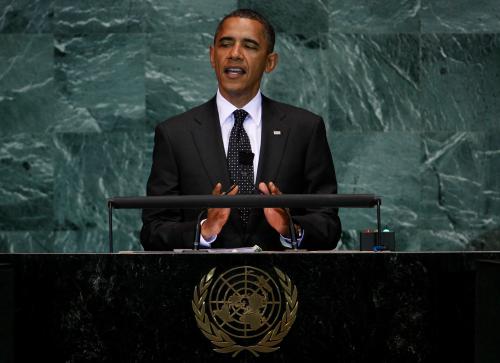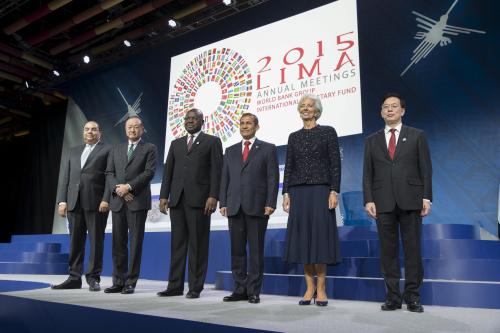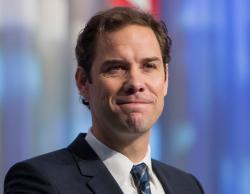The internationally agreed Sustainable Development Goals (SDGs) are starting to become a reference point for a wide range of public and private actors. In recent weeks, for example, New York City declared it will be the first major city to report directly to the United Nations on its progress toward the relevant economic, social, and environment targets for 2030. This came shortly after an array of Canadian federal ministers emphasized the goals’ importance both domestically and internationally. Meanwhile, in the big leagues of business, many of the world’s foremost institutional investors have indicated (e.g., here, here, and here) they are considering integrating the SDGs into their investment processes. Even Kanye West, the celebrity artist, posted the 17 goals for his 28 million Twitter followers, to many people’s surprise.
Will the momentum continue to build? The SDGs still have a long road to travel if they want to penetrate broader public consciousness, at least as measured by traditional media coverage. This assertion is based on findings from our recent article published in Global Policy, which tracks the evolution of predecessor Millennium Development Goal (MDG) and SDG mentions in a cross-section of 16 major print media outlets and 13 academic journals from 2000 to 2016, updating results from a working paper first published in 2015. It is undeniable that the nature of public discourse has evolved rapidly over the past decade, especially in the context of digital technologies—two-thirds of Americans now report getting their news on social media sites—but newspaper content provides a consistent analytical benchmark that can be tracked all the way back to 2000.
Our paper found that, in advanced economy media markets, coverage of global goals jumps in U.N. summit years but tends to lag in off-summit years. To illustrate, Figure 1 indicates the annual frequency of MDG and SDG mentions in three major newspapers: The Guardian, the Financial Times, and The New York Times. In these outlets, there was a gradual buildup of MDG coverage during the early 2000s, followed by pronounced spikes linked to major U.N. summits in 2005, 2008, and 2010. Each newspaper then had a relative lull in coverage before another upward tick in 2015, the year of the major SDG adoption summit. In both The Guardian and The New York Times, MDG-SDG coverage was greater in 2015 than in any of the previous 15 years, while the upswing was more modest in the Financial Times. But in 2016, coverage across all three papers dropped to numbers typical of a pre-2015 non-summit year. At least up to the end of 2016, it was not clear if these news outlets were paying substantively different attention to the SDGs than they had been to the MDGs.
Figure 1. MDG and SDG coverage across select advanced economy newspapers, 2000-2016
Figure 2 shows fairly different dynamics for a selection of newspapers from emerging economies: The Times of India, The Star (of South Africa), and the Vanguard (of Nigeria). Although these papers don’t have searchable data all the way back to the early 2000s, the first thing that jumps out in the figure is the somewhat higher number of MDG-SDG mentions compared to the publications from advanced economies in Figure 1. However, the three papers saw only a small jump in coverage in 2015. Then The Star and the Vanguard saw a typical post-summit year drop in mentions in 2016. The Times of India was a notable exception: It was one of only two papers in our sample that had its highest number of MDG-SDG mentions in 2016, relative to the preceding years. (The other was USA Today, which had only two relevant articles in 2016, compared to one in each of a handful of earlier years.) It would be unwise to draw too many conclusions from these simple article counts, but they do suggest that the SDGs might have already become a significantly more common reference point in India than the MDGs were during the full period up to 2015.
Figure 2: MDG & SDG coverage across select emerging economy newspapers, 2000-2016
ACADEMIC PAPERS
Our Global Policy article also considers the extent to which the MDGs were referenced across a range of prominent relevant academic outlets through the end of 2015. (Given the longer gestation periods for many academic papers, we thought it too early to examine SDG mentions at the time of submission.) When our working paper found that the global health journal The Lancet had the highest number of MDG references among 12 academic journals we examined, we originally wrote, “… it is probably not a coincidence that global health saw the most significant MDG breakthroughs.” Our new version adds The BMJ (formerly British Medical Journal) to the sample, lending further support to this hypothesis. The prevalence of MDG references in The Lancet and The BMJ suggest that at least some portion of the health research community considered itself as MDG protagonist—an outlook seemingly not shared across all academic disciplines. The leading economics journals, for instance, rank among the lowest in terms of MDG references. Nonetheless, World Development, the prominent cross-disciplinary social science journal, did register the largest share of articles mentioning the MDGs, at 8.6 percent.
In our original working paper, we also found that the World Bank and regional development banks’ research papers paid only modest specific attention to the MDGs. A more up-to-date look at the numbers tells a similar story: In 2015, only 6.6 percent of World Bank policy research working papers made mention of the MDGs. As for the SDGs, according to a quick search earlier this month of the World Bank’s working papers site, only nine World Bank policy research working papers published since 2015 mention the term “sustainable development goals.” The SDGs don’t yet appear to set an important guide star for the organization’s policy research machinery.
WHAT NEXT?
Next month the U.N. will convene its annual “high-level political forum” on the SDGs. This is where different countries take turns each year to describe their own progress toward the goals and map out next steps. Amid all the likely discussions on indicators, policies, and processes, one of the most important things for delegates to discuss is how to engage people far away from the U.N. spotlight—citizens, businesses, researchers, journalists, and social media users alike—to make them feel included in the SDG debates. Achieving the goals will require thoughtful ongoing conversations in communities around the globe. The increasingly decentralized and digitized nature of public discourse will require new approaches to promoting SDG-relevant debates. Each constituency needs to figure out its own path. Sustained spotlights from public and private leaders could help provide a crucial first step.
Photo Credit: Mr. Yuan Tao and Ms. Yan Lu. https://www.globalgoals.org/resources







Commentary
Who is talking about the UN Sustainable Development Goals?
June 14, 2018